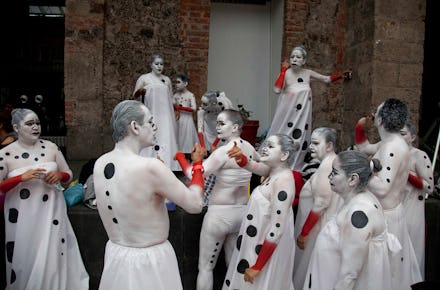9 Photos Show a Side to Mexico That the U.S. Media Doesn't Usually Show You

Think to the last news story you heard about Mexico, and it probably involved the heated debate over immigration reform in the United States or the Mexico's struggle against drug cartels.
And now, more than ever, the media is painting a grim picture of the multi-faceted crisis brewing at the U.S.-Mexico border, where a recent surge in undocumented, unaccompanied children are moving between the two countries at a rate of more than 1,000 per week. President Barack Obama has called it a "humanitarian crisis," and all eyes are on the White House as the government decides its next move.
The images pieced together in the news — of corruption, poverty, violence and crime — are grim, but they don't capture the full, textured reality of life in Mexico. As there are approximately 33.7 million Mexican-Americans living in the United States today, it is worth thinking more about what the country looks like beyond the headlines.
Here are some photos that show a side to Mexico that we don't usually see in the media:
1. It has 300 spoken languages.
Not only does Mexico have the largest Spanish-speaking population in the world, it is also home to over 10 million people who speak an indigenous language. Some of the languages are at risk of becoming extinct.
Approximately 68 legally valid linguistic groups and 364 specific varieties of indigenous languages are spoken in Mexico. How many languages do you know?
2. It has some of the world's best musical festivals.
Since 1998, Vive Latino has been one of the most important Latino, Spanish and Indie music festivals in the world. This year's festival in Mexico City hosted over 173 bands in four days.
3. Impressive museums showcase the rich history.
From a museum of Mexican railroads to its own wax museum to a whole establishment dedicated to Mexican toys throughout history, Mexico is home to hundreds of specialty museums. The National Museum of Anthropology is its most visited, boasting artifacts from Mayan civilizations and an incredible Aztec calendar stone. Mexico's almost perfect weather allows for the museum to be partly outdoors with gorgeous gardens and outdoor exhibits.
4. It is home to several "Ring of Fire" volcanoes.
Scattered across Mexico are breathtaking volcanoes, some of which are active. The volcanic belt, Sierra Nevada, which is part of the "Ring of Fire," spans across Mexico. Its highest peaks have snow all year round and are visible to local residents during clear weather.
5. It is seeing a huge car boom.
By the end of next year, Mexico is expected to overtake Japan and Canada as America's No. 1 source of imported cars. The manufacturing of cars in Mexico has exploded over the past few years, and its output is expected to rise 50% by 2019.
6. It is home to some incredible ancient murals.
Mexico has a history with murals that goes back to ancient civilizations. The murals movement in Mexico was born in the 1920s after the Mexican revolution as a way to show that art is for the public, and is not just empty output. The murals have historically been collective projects and a way for a group of artists to bring together political and cultural art. It even brought Secretary of State John Kerry to take a tour of the Diego Rivera murals of the National Palace in Mexico City.
7. It invented the coolest way to wrestle.
Lucha Libre is a type of Mexican wrestling with bright masks covering the fighters' faces. It can also be characterized by "high-flying maneuvers." Flying fighters? Sign us up.
8. It has a thriving fashion industry.
Mexico's fashion week is a highly anticipated event for fashion designers internationally, even if it is smaller than the others. This year featured 22 collections, which some reviewers called less trend-driven and more authentic than collections shown at larger fashion weeks such as New York and London.
9. It has a fast-growing environmental movement.
Cancun held the UN Climate Change Summit in 2010, where thousands of protesters from around the world marched for new climate change policy. Protesters even donned famous faces to get their point across. Mexico's president introduced climate change legislation in 2012, but the effects have shown to be less than satisfactory due to lack of funding and lack of a national climate change system.